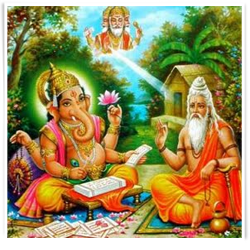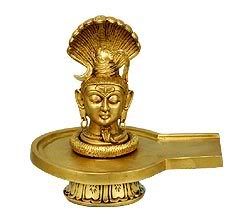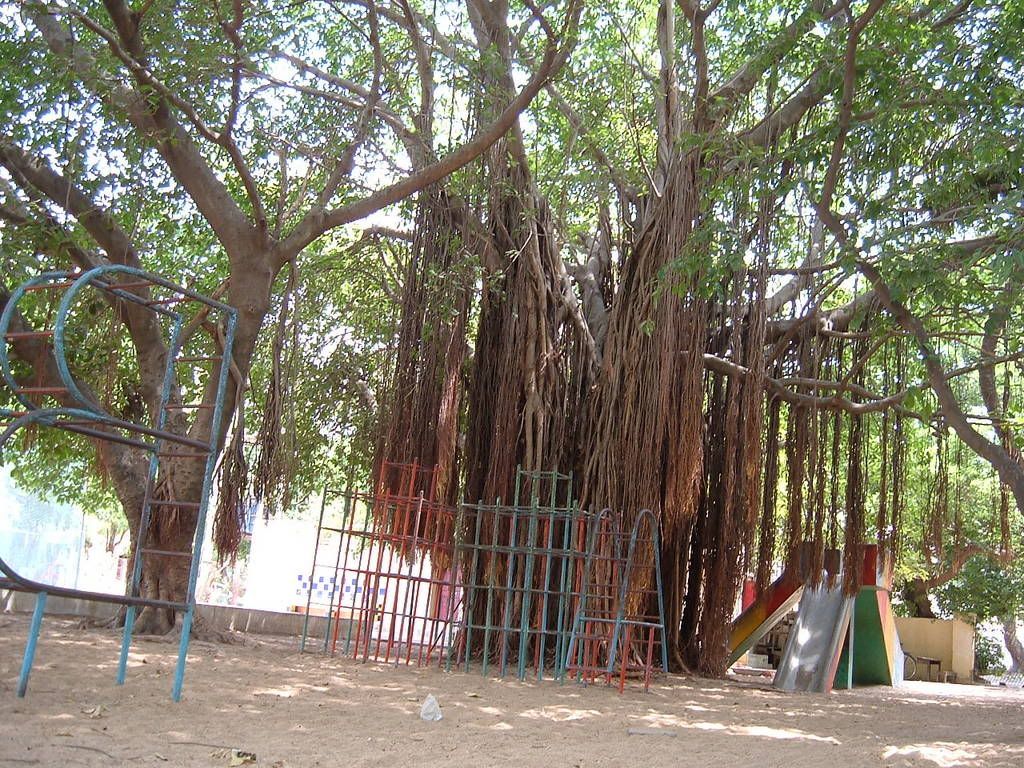The Mahabharata war has ended. Eighteen akshauhinis of warriors have been slaughtered. Bheeshma is lying in the bed of arrows waiting for Uttarayana so that he can end his life. Legends Drona, Karna, Shalya, Jayadratha have been decimated. Every one of the hundred sons of Gandhari has been killed by Bheema, their wives turned widows. Draupadi has lost all her children, her father and her brothers to the war. The battle-field is filled with clotted blood in which chopped off hands and heads lie in heaps, headless bodies lie strewn, crowns, ornaments, weapons lie scattered everywhere, no more of use to their erstwhile owners. There are jackals and vultures tearing the flesh off the bodies of men and war animals and pulling at the intestines of the dead. Ghouls and cannibals mingle with ease with carrion birds and carnivores to feast on the slaughtered.
In the middle of all these, women, widows who have lost their husbands, sisters who have lost their brothers, mothers who have lost their sons, daughters who have lost their fathers, begin moving towards the battlefield to have a final look at their lost ones. They have removed their ornaments, their hair is open, each of them is clad in a single piece of cloth, every eye is filled with tears, every cheek drenched. Heart-rending wails fill the directions. And in the middle of all this, a poet, arguably the greatest this ancient land of ours has seen, a sage at whose feet sages from all over the land fall in reverence, his heart overflowing with indescribable sorrow, sees a sight the beauty of which fills his heart with such thrill that he sings out ecstatically of how the women coming out of the Kaurava homes look like spotted deer coming out of dark caves in white mountains!
Hearing that Dhritarashtra and the widows and mothers of the dead are on their way to the war field, Yudhishthira, along with his brothers and Draupadi and Krishna, goes to meet him. They too are mourners as much as Dhritarashtra is, as much as the widows and the mothers are. On the banks of the Ganga they come across group after group of women wailing aloud inconsolably like lamenting kurari birds.
They gather around Yudhishthira and ask him:
“Where is your famous dharma now, oh king, that you have killed your own uncles, brothers, the sons of your teachers and friends? How wonderful do you feel after killing Drona, grandsire Bheeshma and Jayadratha? How will you enjoy this kingdom now that you have lost your elders, your bothers, Abhimanyu and all the sons of Draupadi?”
Without a word to them, his head bent low, Yudhishthira wades through the masses of lamenting women and moves towards the weeping Dhritarashtra. One by one the Pandavas bow down to their father’s elder brother, each telling him his name.
Dhritarashtra, the tormented, mourning father of a hundred slain sons, hugs Yudhishthira, the cause of the death of his sons, with no pleasure in his heart. After consoling the eldest of his brother’s sons, the old man, his heart filled with murderous evil, starts searching for Bheema as if he would burn the slayer of his sons transforming himself into a fire, The conflagration of his anger fanned by winds of deep sorrow looks as if it wants to reduce the forest that is Bheema to ashes.
Krishna, who had expected exactly this reaction from Dhritarashtra, is prepared and quickly pushes Bheema away and thrusts forward in his place the iron statue of Bheema that Duryodhana had got made and on which he used to vent his hatred. Mistaking the statue for Bheema, Dhritarashtra, famed to have the strength of a hundred elephants in his arms, takes the statue into the deadly grip of his arms and crushes it in his dark fury. As he does it, blood comes out of his mouth and injured chest. Bathed in blood, the mighty Dhritarashtra falls down on the ground. As he lies there Vyasa sees great beauty in the fallen, blood-bathed, dark-hearted Dhritarashtra whose greed for power is perhaps more responsible than anything else for the holocaust that has just occurred.
To Vyasa, the fallen Dhritarashtra looks like a parijata tree that has just fallen down, its branches thick with crimson-hued flowers!
The man who has just fallen down after that murderous act that is the consummation of his lifelong hatred for Bheema is Vyasa’s own son – born of his flesh and blood. The women who were wailing aloud and proceeding to the battlefield to have a last look at the bodies of their fathers, brothers and sons were his daughters-in-law, his granddaughters-in-law, and other close relatives, wailing for the death of his own blood and flesh. And yet Vyasa’s sees beauty in it all.
Let us take one more example. This one appears in the Shalya Parva of the Mahabharata. Yudhishthira and Shalya fight a terrible, long battle. At the end of it, Yudhishthira looks so furious he appears to be dancing in anger in the battlefield. In the words of the Mahabharata, like Rudra shooting the life-taking arrow at the Asura Andhaka, appearing at the moment like Maheshwara slaying the Tripuras, the wrathful Yudhishthira attacks Shalya with a shakti using all his force. Listen to the words of Vyasa describing the fall of Shalya at the end of this savage war:
Like a beloved who welcomes in eager love the lover falling on her, the earth seemed to rise forward to receive the mighty Shalya falling on her. Like a man who falls asleep on the body of his beloved exhausted after a prolonged session of lovemaking, the king looked as though he was sleeping as he fell on the earth that he had long enjoyed embracing her with all his limbs.
Vyasa sees Bheema standing with blood oozing from his many wounds like a lovelykinshuka plant in red blossom. To him Bheeshma bathed in blood from his several wounds looks like a beautiful Ashoka in flowers. Shikhandi, shafts sticking from his shoulders, looks like a splendid tree with spreading branches and twigs.
Vyasa is by no stretch of imagination a sadist lover of blood and war. He is no lover of the beauty of the battlefield or the cremation ground. Sorrow and pain do not please him, misery does not thrill him. Wrath and vengeance do not send shivers of ecstasy down his spine. And yet Vyasa describes all these with the same rapturous thrill with which he would describe the young love between a man and a woman, the smile of a baby, the beauty of a mountain river, the glory of a dawn, the coming home of birds to their roosts at sundown.
How can a sage-poet glorify a war in which blood flows in torrents? How can you be euphoric about the vicious slaughtering of men in their hundreds of thousands? How can you glorify the heart-rending death cries of multitudes of the slain? How can you find beauty in throngs of wailing women rushing towards a battlefield in which their husbands, fathers, brothers and sons lie with their limbs chopped off, their heads hacked away, their bodies already food to ghouls and carrion birds and carnivores?
Vyasa can. He can do it with complete abandon. He can do it with the ease of a torrent running down a mountain, with the naturalness of a river rushing to the ocean. He can do it with the same spontaneity with which the Upanishad rishi can sing “ahamannnamahamannam, ahamannado’hamannadah” – I am food and I am the eater of food. I am all that exists in this world of objects and I am also the destroyer of all that is in this world. And that is what makes Vyasa greater than any other poet the world has seen.
To us Indians, Shiva is not only the source of everything that is beautiful, everything that is sacred, all that is satyam, shivam and sundaram, but the destroyer too. And the Rudraprashna can sing his praise saying namo bhavaya cha rudraya cha, salutations to the creator and the destroyer, and say mrtyave svaha, mrtyave svaha – here, to death; here, to death, this offering of mine.
If srishti, creation, is sacred, then samhara, destruction is no less sacred. If birth is sacred, so is death. The Rudraprashna calls God the one present in vice and in virtue, in piece and in violence, in joy and in sorrow, in life, in death and in liberation. He is there in green fields and farmyards, in trees and in creepers, in sound and its echo. He is in the seated and in the reclining, in the sleeping and in those who are awake, in the static and in the dynamic. He is present in noisy waves and in still waters, is formless and yet with manifold forms, the primordial one. There is nothing in which he is not present.
Our culture has taught us to worship Kali. Kali who is digambari and muktakeshi – clothed in the directions, her hair unbound and free. Kali who wears a garland of skulls, from whose ears hang the carcasses of freshly killed infants, from whose tongue drips red blood, her many hands holding weapons of terrible death. Kali who is seated on Shiva lying prostrate on the earth, making fierce love to him as though she is engaged in a battle with him, and roaring thunderously in her ecstasy, shaking the very directions. For, if she is death, she is also the mother, the source of all life, which she brings forth mating with Shiva.
To us all life is sacred and that sacred life is like Kali. Violent and gentle at once, savage slayer and tender lover, life and death. If one moment life is a savage battle, the next it is passionate lovemaking. And since everything is sacred, everything is beautiful. Immensely, indescribably, thrillingly, rapturously beautiful.
To Vyasa, whose consciousness is seated in the turiya, beyond the vishwa, taijasaand prajna levels, all life is Kali dancing her terrifying, marvelously beautiful dance. And every step of that dance is beautiful, every movement, a rapture.
Vyasa can sing ecstatically of the beauty of death and of the radiance of sorrow, just as he can sing of the beauty of life and the radiance of joy.
And he can sing ecstatically with complete detachment. For, this great sage-poet is as much a witness to life as he is a participant in it, as much in the audience as on the stage.
That is why he can talk without any reservations about his own mother’s birth through an emperor’s lust, through what could very well have been a rape, a poor, hapless woman taken against her will. Beginning the Mahabharata story, after a chapter which explains how he wrote the epic, Vyasa narrates the story of Uparichara Vasu who had to go on a hunting trip against his will ignoring the invitation of his wife who had just completed her ritual bath after her monthly periods and had sent a message to the king telling him she was waiting for him in their bed. In the spring jungle, surrounded by nature in her estrous glory, the whole forest filled with the sights, sounds and scents of sex as animals and birds called for each other, sported and mated, Vasu could not control himself. Satyavati, Vyasa’s mother, is one of the two children born to him by Adrika, who could very well have been a fisherwoman on the banks of the Yamuna whom the emperor used to satisfy his lust. There is no shame in Vyasa as he narrates the story of his grandfather’s lust and how his mother was born, though subsequent retellings have altered this story almost beyond recognition, not surprising since none of these narrators was another Vyasa.
Nor is there any shame in him when he speaks of his own birth. He narrates with complete dispassion how Sage Parashara saw his mother, a dark, foul-smelling young girl engaged in ferrying passengers across the Yamuna then, and lusted for her. He would speak with the same detachment of how he himself could not retain self-control at the sight of the Apsara Shuki and how his son Shuka was born to her. And then he will proceed to speak without inhibitions of the lusts of the future generations of his family – of sexual lusts, of power lusts, of vengeance lusts, of violence lusts.
He will speak passionately with the same dispassion about the great love of Gandhari for her son Duryodhana and her refusal, in spite of it, to bless him with victory day after day on every one of those eighteen days of war when he came seeking her blessings; of Kunti’s admirable goading of her sons to kshatriya-like action through the story of Vidula and of her shameless going to her son Karna, whom she had betrayed all her life, seeking favors from him on the eve of the war; of Duryaodhana’s bold villainy and of Yudhishthira’s cowardly righteousness, of Draupadi’s devotion to her husbands and of her betrayal by each one of them, of the shame she was subjected to in the Kaurava assembly and the shame the Kauravas subjected themselves to through their actions on that day, of the victories and failures on both sides of the war, of the fearlessness and cowardice of heroes in both the armies.
He will sing passionately with the same dispassion, of exultation and of heartbreak, of generosity and of greed, and of honor and of dishonor, of misery, wretchedness, distress and anguish and of felicity, exhilaration and rapture.
Which is possible because Vyasa was not only a witness to life around him, but to himself too. That is what turiya means – witness consciousness, witness to oneself.
The entire Mahabharata is the narration of a sage-poet of boundless wisdom who was both a participant and a witness to the drama of life that was unfolded through him and all around him – witness in the spiritual, in the Vedantic sense. That explains the passion and dispassion that Vyasa simultaneously displays throughout the narration of the epic – his passionate dispassion, his dispassionate passion. And that is what makes Vyasa’s epic truly different from other great works of literature.
~*~
I have heard a story about Neil Armstrong, the man who took that first historic step on the moon. It is said that as he stood on the moon and looked at the earth in the distant sky, something tremendous happened to him. The vast earth was reduced to him to a small, distant object in the sky – national boundaries disappeared, continents blurred. And when that happened, many things that are vitally important to us down here suddenly shrunk to insignificance. For instance, from that vantage point, how important is an individual human being? How big is he? And how big are his daily concerns? The boundary dispute he has with his next-door neighbor – how important is that? And how important is that quarrel between brothers about the division of their ancestral property?
The story says that as realization dawned, Armstrong lost his mental balance on the moon and back on the earth, he had to be under psychiatric care for years.
Vyasa, the great sage, saw the asarata, the insignificance, of samsara from the vantage point of his turiya consciousness more clearly than Armstrong saw the insignificance of our petty concerns from the moon. It is Vyasa’s greatness that in spite of this we see him working tirelessly for life and joy, for piece and harmony, for understanding and acceptance. When his mother beckons him because the children for whose sake her father had had Bheeshma disinherited have both died and the ancient dynastic line of the Bharatas is facing extinction, he comes readily and does her bidding, though by every account the niyogas he performed in the wives of Vichitraveerya were not to his heart. He wanted it to be done at least a year later, a year during which the princesses would purify themselves through austerities – but his mother said she couldn’t wait and he obliged. When Ambika was asked to undergo niyoga a second time and shrinking away from it remembering her earlier experience she sent her maid in her place, the sage did not fail to oblige the woman who felt blessed by the honor though he did recognize her as a maid.
He is there for Gandhari’s aid when she in her frustration hits her stomach hard and brings out from her womb a mass of flesh – it is under his care that that mass of flesh becomes human. From those early incidents onwards, Vyasa is there everywhere in the Mahabharata, every time there is a crisis, offering his services to those in need. And at the end, after the great war has ended and in that terrible post-war incident when the world is threatened with extinction because of the brahmashira astrasreleased by Ashwatthama and Arjuna, as the all-annihilating weapons move towards each other, he is there, to stand in between them so that they do not clash and wipe out the world, in what is probably the greatest show of his immense spiritual power.
The beautiful shlokas of Jeevanmuktananda Lahari of Adi Shankara, that endless source of beauty and wisdom, say:
Pure pauraan pashyan narayuvatinaamaakrtimayaan
Suveshaan svarnaalankaranakalitaan chitrasadrshaan
Svayam saakshee drashtetyapi cha kalayan tais saha raman
Munir na vyaamoham bhajati gurudeekshaakshatatamaah.
Seeing the people of the city, men and young women of different forms clad in attractive dress and decked with ornaments of gold, beautiful as paintings, the sage joyously interacts with them – yet he never gets deluded, blessed with the grace of his master, for in his heart is the knowledge that he is the witness, the watcher of them all, and of himself.
Kadaachit praasaade kvachidapi cha saudhe cha dhavale
Kadaakaale shaile kvachidapi cha kooleshu saritaam
Kuteere daantaanaam munijanavaraanaamapi vasan
Munir na vyaamoham bhajati gurudeekshaakshatatamaah.
Living at times in mighty palaces and at others in pearly mansions; at times on mountaintops and at others on the banks of rivers, and again in the huts of great hermits, the sage never gets deluded, blessed with the grace of his master – for in his heart is the knowledge that he is the witness, the watcher of them all, and of himself.
Kvachid baalais saardham karatalajataalaish cha hasitaih
Kvachit taarunyaankitachaturanaaryaa saha raman
Kvachid vrddhaish chintaam kvachidapi tadanyaish cha vilapan
Munir na vyaamoham bhajati gurudeekshaakshatatamaah.
At times clapping his hands and laughing in delight with children and at others reveling with smart, young women endowed with rich youth, at times lamenting with old men sad with heavy hearts, the sage never gets deluded, blessed with the grace of his master – for in his heart is the knowledge that he is the witness, the watcher of them all, and of himself.
Kadaachit sattvasthah kvachidapi rajovrttiyugatah
Tamovrttih kvaapi tritayarahitah kvaapi cha punah
Kadaachit samsaaree shrutipathavihaaree kvachidaho
Munir na vyaamoham bhajati gurudeekshaakshatatamaah.
At times he is full of sattva, at others he is endowed with rajas; at times he acts out of dark tamas and at others he is beyond all the three gunas. At times he is a samsareeand at others he walks on the path of the highest wisdom. Yet the sage never gets deluded, blessed with the grace of his master – for in his heart is the knowledge that he is the witness, the watcher of them all and of himself.
That is Vyasa. These verses are about him: a great witness to his own self, a great witness to life.









